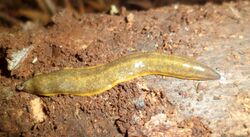Biology:Cratera ochra
| Cratera ochra | |
|---|---|

| |
| In São Francisco de Paula National Forest | |
| Scientific classification | |
| Domain: | Eukaryota |
| Kingdom: | Animalia |
| Phylum: | Platyhelminthes |
| Order: | Tricladida |
| Family: | Geoplanidae |
| Genus: | Cratera |
| Species: | C. ochra
|
| Binomial name | |
| Cratera ochra Rossi, Amaral, Ribeiro, Cauduro, Fick, Valiati & Leal-Zanchet, 2015
| |
Cratera ochra is a species of land planarian in the subfamily Geoplaninae. It is found in Brazil
Description
Cratera ochra is a medium-sized land planarian with a lanceolate body, reaching up to 85 millimetres (3.3 in) in length. The color of the dorsum is yellow-ochre covered with a dispersed greyish to greyish-brown pigmentation forming two diffuse and irregular longitudinal bands and two paramarginal longitudinal stripes slightly darker than the bands. The ventral side is pale-yellow.[1]
The several eyes of C. ochra are distributed marginally in the first millimeters of the body and posteriorly become dorsal, occupying around 40% of the body width on each side at the median third of the body.[1]
Aside from its coloration and dorsal eyes, C. ochra is distinguished from other members of Cratera by a glandular margin with four or more types of glands, a cylindrical pharynx, an extrabulbar prostatic vesicle with an ample, expanded proximal portion and a tubular distal portion, and ovovitelline ducts that emerge dorsally from the middle of the ovaries and ascend anterior to the gonopore.[1]
Etymology
The specific epithet ochra refers to the yellow-ochre color of the animal's dorsum.[1]
Distribution
The habitat of C. ochra includes moist forests in northeast Rio Grande do Sul, southern Brazil, as well as plantations of Araucaria angustifolia and Pinus spp.[1]
References
- ↑ 1.0 1.1 1.2 1.3 1.4 Rossi, Ilana; Amaral, Silvana Vargas; Ribeiro, Giovana Gamino; Cauduro, Guilherme Pinto; Fick, Israel; Valiati, Victor Hugo; Leal-Zanchet, Ana Maria (2015). "Two new Geoplaninae species (Platyhelminthes: Continenticola) from Southern Brazil based on an integrative taxonomic approach". Journal of Natural History 50 (13–14): 787–815. doi:10.1080/00222933.2015.1084057. ISSN 0022-2933. https://zenodo.org/record/3990049.
Wikidata ☰ Q25095706 entry
 |

